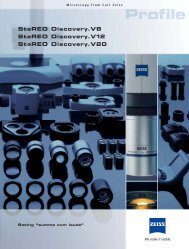SPOT 4.1 Basic and Advanced Software Manual for SPOT Insight ...
SPOT 4.1 Basic and Advanced Software Manual for SPOT Insight ...
SPOT 4.1 Basic and Advanced Software Manual for SPOT Insight ...
You also want an ePaper? Increase the reach of your titles
YUMPU automatically turns print PDFs into web optimized ePapers that Google loves.
Ch. 8 – Viewing, Editing, <strong>and</strong> Annotating ImagesTo merge images, follow these steps:1. Define the source <strong>for</strong>each image.At least two Source Images must be selected. If the image that you select ispart of an image sequence, the Sequence Index box is also active. The sourcecan be:2. Specify the brightness(Scale Factor) <strong>for</strong>individual images3. Specify the PositionOffsets <strong>for</strong> individualimages4. If you have definedposition offsets, specifywhether the mergedimage will retain the nonoverlappingareas.5. Specify the Auto-Scalebrightness setting <strong>for</strong> thefinal merged image.6. Preview your mergedimage.• A Currently Open Document – Select Currently Open Document to mergea currently open image. Specify the number of the image in the sequence,if applicable.• An image on File – Select File to merge a file from disk. Either enter the filepath in the box, or click on the browse button (to the right of the box) tosearch <strong>for</strong> <strong>and</strong> select a file from disk. Specify the number of the image inthe sequence if applicable.• A Database (Windows only) – Select Database to merge a <strong>SPOT</strong>database image. To merge a database image you must enter the Image ID<strong>for</strong> that image. You can determine the eight-digit Image ID number bysearching the database <strong>for</strong> the image that you want to add. The searchresults display the image ID number. In order to select a database image,the database must be open.When you are merging monochrome images, the program uses whatever palettethat you have set <strong>for</strong> that image. So, if you defined a specific palette <strong>for</strong> animage, that color appears in the merged image. If a palette has not beenassigned to an image, the program uses the grayscale palette as a default.Palettes cannot be applied to monochrome images through the Merge Imagesfunction. They must be applied prior to merging the image, either via the ImageSetup window (pre-capture) or the Set Palette Edit menu option (post capture).• For in<strong>for</strong>mation on defining palettes, refer to Ch. 4 – Working in <strong>Advanced</strong>Mode.• For in<strong>for</strong>mation on applying a palettes to an image as part of the imagecapture process, refer to the Palette Image Setup option, as discussed inCh. 5 – Preparing to Take a Picture (<strong>Insight</strong> B/W users only).• For in<strong>for</strong>mation on applying a palette to a captured image, refer to the SetPalette Edit menu option, as discussed in this chapter.For each source image, specify a Scale Factor between .01 <strong>and</strong> 5.• Numbers between .01 <strong>and</strong> 1 darken the image.• Numbers between 1 <strong>and</strong> 5 lighten the image.Changing filters <strong>for</strong> an image capture can cause its position to shift from that ofthe previous capture. This can be problematic when trying to merge two or threeimages captured with different filters. The Position Offsets <strong>for</strong> each individualimage in the merged image allow you to compensate <strong>for</strong> such shifts byspecifying Horizontal <strong>and</strong> Vertical Position Offsets in pixels.To retain the non-overlapping areas, ensure that the Include Non-OverlappingAreas in Final Image box is selected. If you do not select the box, the finalimage automatically discards any non-overlapping areas.Whereas the Scale Factors are applied to individual images be<strong>for</strong>e they areMerged, the Auto-Scale Brightness feature automatically adjusts the brightnessof the merged image to prevent overlapping bright areas from burning out.Click on Apply to apply your settings <strong>and</strong> view the merged image. When youclick on Apply, the Merge Images dialogue remains open, allowing you toexperiment with different Scale Factors <strong>and</strong> Position Offsets. Whenexperimenting with different values, click on Shrink to view only the ScaleFactors <strong>and</strong> Position Offsets – this minimizes the amount of space that theMerge Images dialogue takes up in the window.7. Click on OK. When you are satisfied with the appearance of the merged image, click on OK toapply the settings <strong>and</strong> close the Merge Images dialogue.160 User Guide to the <strong>SPOT</strong> <strong>Insight</strong> Camera
















